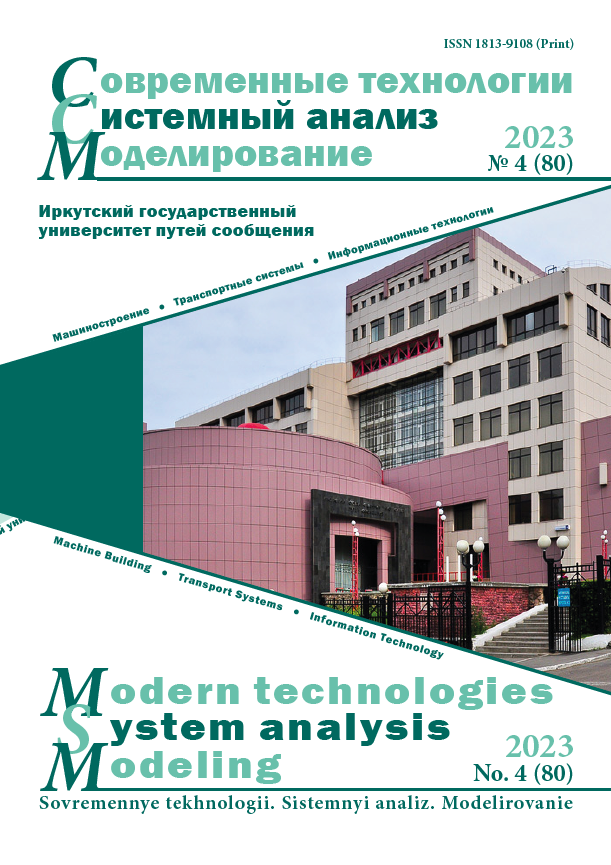New approaches to modeling the stability of a long-welded rails in the environment of finite element analysis
Keywords:
joint-free track, stability, track ejection, modeling, criteria for loss of stabilityAbstract
The article discusses the existing approaches to solving the currently relevant issue concerning the safe expansion of the landfill of a joint-free track with the prevention of counter ejection stability loss. The study has been conducted of the existing methods for assessing the stability margin of a seamless path, ranging from the simplest ones not requiring significant calculations, to methods implemented with the help of specialized software, their advantages, disadvantages and possible applications depending on the range of tasks to be solved. A jointless track section model made in the environment of finite element analysis is presented, optimal in terms of the range width of setting initial conditions and obtaining output data (results). The methods of leveling one of the most significant disadvantages of the finite element method are shown i.e./ avoiding the need to rebuild the model when changing the initial data due to the developed macro programs in the Visual Basic for Applications environment, greatly simplifying the process of forming models, as well as output and analysis of results. The work also shows a new approach for determining the parameters of the maximum permissible rail temperature excess, relative to the fixing temperature, based on modeling the ejection process, which allows to obtain stability parameters for any track structure. At the same time, using the methods of probability theory, the values of critical temperatures are calculated for the pre-selected criteria for assessing the stability margin of a jointless track, whose statistical relationship, when using modeling and empirical methods, is maximal, which makes it possible to obtain «conditionally empirical» values of the temperature increase of the rail lash allowed by the stability tolerance of the track.
References
Об утверждении и введении в действие инструкции по устройству, укладке, содержанию и ремонту бесстыкового пути : распоряжение ОАО «РЖД» от 14.12.2016 № 2544р (ред. 10.04.2023). Доступ из справ.-правовой системы АСПИЖТ в локал. сети.
Мищенко К.Н. Бесстыковой рельсовый путь. М. : Трансжелдориздат, 1950. 88 с.
Першин С.П. Метод расчета устойчивости бесстыкового пути. // Труды МИИТ : сб. ст. М., 1962. Вып. 147 : путь и путевое хозяйство. С. 28–97.
Ершов В.В. Аналитический метод определения устойчивости бесстыкового пути // Путь и путевое хозяйство. 2006. № 6. С. 10–12.
Ершов В.В. Устойчивость бесстыкового пути при отступлениях от норм содержания // Путь и путевое хозяйство. 2008. № 3. С. 13–15.
Ершов В.В., Корся В.Б., Шувалова О.М. Выбор расчетного сечения при определении поперечной устойчивости бесстыкового пути // Путь и путевое хозяйство. 2010. № 6. С. 27–28.
Новакович В.И., Карпачевский Г.В., Курилина И.А. Изменения в рельсошпальной решетке при воздействии поездов // Путь и путевое хозяйство. 2004. № 5. С. 25–28.
Новакович В.И. Продольные силы при вывеске рельсошпальной решетки бесстыкового пути // Вестник ВНИИЖТ. 1967. № 6. С. 49–52.
Новакович В.И. О ползучести бесстыкового пути в поперечном направлении под действием продольных сил // Вестник ВНИИЖТ. 1976. № 5. С. 39–42.
Коган А.Я., Грищенко В.А., Косенюк В.К. Устойчивость бесстыкового пути при температурном воздействии // Обеспечение надежности и эффективности бесстыкового пути в сложных условиях эксплуатации : межвуз. сб. науч. тр.. Новосибирск, 1991. С. 5–15.
Коган А.Я., Грищенко В.А. Нелинейная устойчивость бесстыкового пути в прямых участках при наихудшей форме начальной ненапряженной неровности // Вестник ВНИИЖТ. 1992. № 3. С. 40–45.
Коган А.Я. Продольные силы в железнодорожном пути. М. : Транспорт, 1967. 168 с.
Коган А.Я., Лебедев А.В. Устойчивость бесстыкового пути при различных конструкциях скреплений и условиях их эксплуатации // Вестник ВНИИЖТ. 2007. № 2. С. 3–9.
Вериго М.Ф. Новые методы в установлении норм устройства и содержания бесстыкового пути. М. : Интекст, 2000. 184 с.
Оценка напряженно-деформированного состояния рельсов при различных условиях эксплуатации на основе моделирования методом конечных элементов / А.Ю. Абдурашитов, Д.В. Овчинников, В.П. Сычев и др. // Известия Транссиба. 2023. № 1 (53). С. 62–73.
Овчинников Д.В. 3D-моделирование напряженно-деформированного состояния элементов пути // Железнодорожный транспорт. 2023. № 3. С. 50–53.
Ovchinnikov D.V., Gall’yamov D.I. Evaluation of Rail Overturning under the Influence of Lateral Forces by Mathematical Modeling // Transportation Research Procedia : proceedings of the XIII International Conference on Transport Infrastructure: Territory Development and Sustainability. Irkutsk, 2022. P. 717–725.
Ковенькин Д.А., Сулемина А.Э., Покацкий В.А. Оценка зоны влияния бокового воздействия подвижного состава на рельсошпальную решетку // Проблемы путевого хозяйства Восточной Сибири : cб. науч. тр. Иркутск, 2004. Т. 2. С. 71–74.
Ковенькин Д.А. Исследование воздействия суммарных боковых сил на элементы верхнего строения пути при вписывании экипажа в кривые участки пути // Проблемы и перспективы изысканий, проектирования, строительства и эксплуатации российских железных дорог : материалы всерос. науч.-практ. конф. Иркутск, 2007. Т. 1. С. 23–26.


